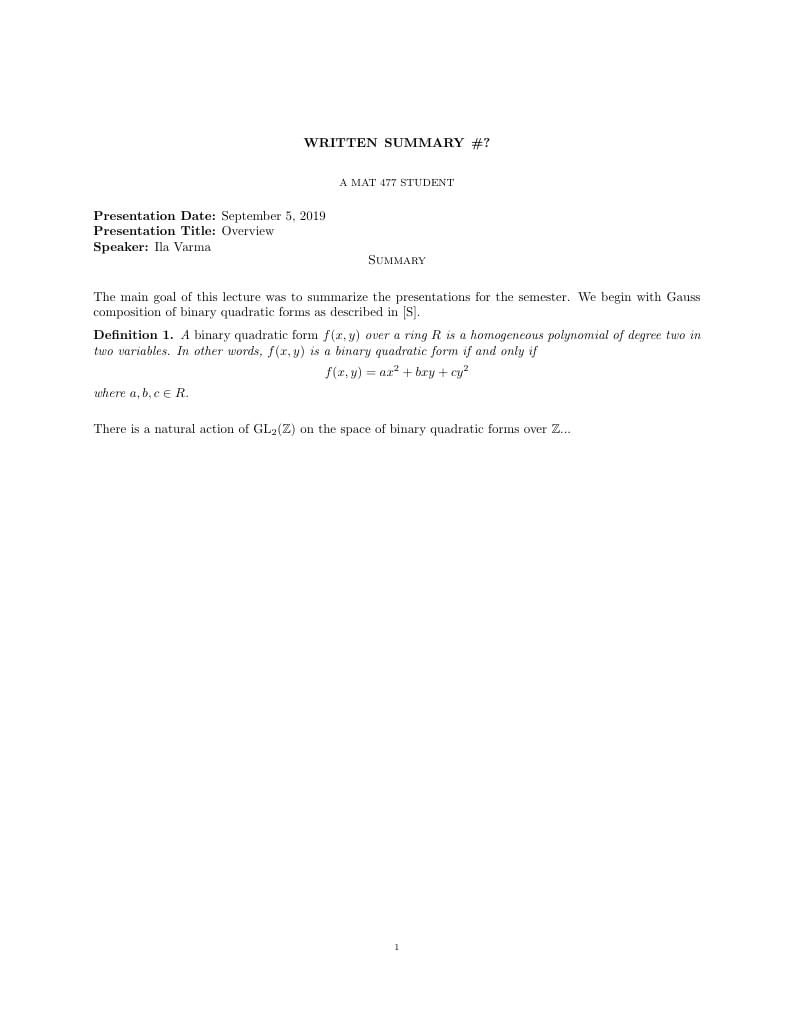
Template for Written Assignments for MAT 477 (Fall 2019)

\documentclass[10pt]{amsart} %fontsize, article stylte
\usepackage[utf8]{inputenc}
\setlength{\parindent}{0em} %indents to paragraphs
\setlength{\parskip}{1em} %lineskips after paragraph breaks
\usepackage[margin=1.0in]{geometry} %margins
%Standard Packages
\usepackage{bbm}
\usepackage{amsmath}
\usepackage{amsthm}
\usepackage{enumerate}
\usepackage{mathtools}
\usepackage{amssymb}
%Standard Environments
\newtheorem{theorem}{Theorem}
\newtheorem{lemma}[theorem]{Lemma}
\newtheorem{proposition}[theorem]{Proposition}
\newtheorem{corollary}[theorem]{Corollary}
\newtheorem{question}{Question}
\newtheorem{definition}[theorem]{Definition}
\newtheorem{conjecture}[theorem]{Conjecture}
\newtheorem{remark}[theorem]{Remark}
%Example of a user-made command
\newcommand{\GL}{{\rm GL}}
%Beginning of Document Information
\title{Written Summary \#?}
\author{A MAT 477 Student}
\begin{document}
\maketitle %making the title show in the document
\vspace{-20pt}
{\bf Presentation Date:} September 5, 2019 \\
{\bf Presentation Title:} Overview\\
{\bf Speaker:} Ila Varma
\vspace{-20pt}
\section*{Summary} % '*' suppresses the numbering
The main goal of this lecture was to summarize the presentations for the semester. We begin with Gauss composition of binary quadratic forms as described in \cite{Seguin}.
\begin{definition}
A {\em binary quadratic form} $f(x,y)$ over a ring $R$ is a homogeneous polynomial of degree two in two variables. In other words, $f(x,y)$ is a binary quadratic form if and only if
$$f(x,y) = ax^2 + bxy + cy^2$$ % equation display
where $a,b,c \in R$.
\end{definition}
There is a natural action of $\GL_2(\mathbb{Z})$ on the space of binary quadratic forms over $\mathbb{Z}$...
\newpage
\begin{thebibliography}{12}%Quick Bibliography
\bibitem[HCL1]{HCL}
M.\ Bhargava, ``Higher composition laws I: A new view on Gauss composition and quadratic generalizations,'' {\it Ann.\ of Math.} {\bf 159} (2004), no.\ 1, 217--250.
%\bibitem[BV]{bv1}
%M.\ Bhargava and I.\ Varma, ``The mean number of 3-torsion elements in the class groups and ideal groups of quadratic orders,'' {\it Proc. of the London Math Soc.} {\bf 112} (2016), no.\ 2, 235--266.
\bibitem[S]{Seguin}
F.\ Seguin, ``Composition of binary quadratic forms: understanding the approaches of Gauss, Dirichlet, and Bhargava,'' to appear in {\it Resonance Journal}.
\end{thebibliography}
\end{document}